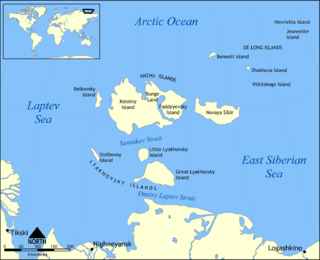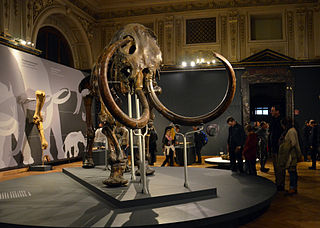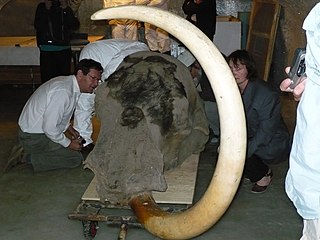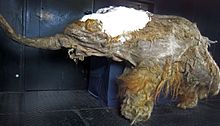
A mammoth is any species of the extinct elephantid genus Mammuthus. They lived from the late Miocene epoch into the Holocene about 4,000 years ago, and various species existed in Africa, Europe, Asia, and North America. Mammoths are distinguished from living elephants by their spirally twisted tusks and in at least some later species, the development of numerous adaptions to living in cold environments, including a thick layer of fur.

Sakha, officially the Republic of Sakha (Yakutia), is the largest republic of Russia, located in the Russian Far East, along the Arctic Ocean, with a population of one million. Sakha comprises half of the area of its governing Far Eastern Federal District, and is the world's largest country subdivision, covering over 3,083,523 square kilometers (1,190,555 sq mi). Yakutsk, which is the world's coldest major city, is its capital and largest city.

The Palearctic or Palaearctic is the largest of the eight biogeographic realms of the Earth. It stretches across all of Eurasia north of the foothills of the Himalayas, and North Africa.

The Lena is a river in the Russian Far East, and is the easternmost of the three great Siberian rivers that flow into the Arctic Ocean. The Lena is the eleventh-longest river in the world, and the longest river entirely within Russia, with a length of 4,294 km (2,668 mi) and a drainage basin of 2,490,000 km2 (960,000 sq mi). Permafrost underlies most of the catchment, 77% of which is continuous.

The woolly rhinoceros, simply known as woolly rhino, is an extinct species of rhinoceros that inhabited northern Eurasia during the Pleistocene epoch. The woolly rhinoceros was a member of the Pleistocene megafauna. The woolly rhinoceros was covered with long, thick hair that allowed it to survive in the extremely cold, harsh mammoth steppe. It had a massive hump reaching from its shoulder and fed mainly on herbaceous plants that grew in the steppe. Mummified carcasses preserved in permafrost and many bone remains of woolly rhinoceroses have been found. Images of woolly rhinoceroses are found among cave paintings in Europe and Asia. The species range contracted towards Siberia beginning around 17,000 years ago, with the youngest known records being around 14,000 years old in northeast Siberia, coinciding with the Bølling–Allerød warming, which likely disrupted its habitat.

The New Siberian Islands are an archipelago in the Extreme North of Russia, to the north of the East Siberian coast between the Laptev Sea and the East Siberian Sea north of the Sakha (Yakutia) Republic, of which they are administratively a part.

The Columbian mammoth is an extinct species of mammoth that inhabited the Americas from southern Canada to Costa Rica during the Pleistocene epoch. The Columbian mammoth descended from Eurasian mammoths that colonised North America during the Early Pleistocene around 1.5–1.3 million years ago, and later experienced hybridisation with the woolly mammoth lineage. The Columbian mammoth was among the last mammoth species, and the pygmy mammoths evolved from them on the Channel Islands of California. The closest extant relative of the Columbian and other mammoths is the Asian elephant.

During the Last Glacial Maximum, the mammoth steppe, also known as steppe-tundra, was once the Earth's most extensive biome. It stretched east-to-west, from the Iberian Peninsula in the west of Europe, across Eurasia to North America, through Beringia and Canada; from north-to-south, the steppe reached from the arctic islands southward to China. The mammoth steppe was cold and dry, and relatively featureless, though topography and geography varied considerably throughout. Some areas featured rivers which, through erosion, naturally created gorges, gulleys, or small glens. The continual glacial recession and advancement over millennia contributed more to the formation of larger valleys and different geographical features. Overall, however, the steppe is known to be flat and expansive grassland. The vegetation was dominated by palatable, high-productivity grasses, herbs and willow shrubs.

Mammuthus trogontherii, sometimes called the steppe mammoth, is an extinct species of mammoth that ranged over most of northern Eurasia during the Early and Middle Pleistocene, approximately 1.7 million-200,000 years ago. One of the largest mammoth species, it evolved in East Asia during the Early Pleistocene, around 1.8 million years ago, before migrating into North America around 1.5 million years ago, and into Europe during the Early/Middle Pleistocene transition, around 1 to 0.7 million years ago. It was the ancestor of the woolly mammoth and Columbian mammoth of the later Pleistocene.
The Sopkarga mammoth, alternately spelled Sopkarginsky mammoth, and informally called Zhenya, after the nickname of its discoverer, is a woolly mammoth carcass found in October 2012. It was discovered 3 kilometres (2 mi) away from the Sopkarga polar weather station on the Taymyr Peninsula in Russia. The Moscow News refers to it as the best preserved mammoth find in the past 100 years.

Lyuba is a female woolly mammoth calf who died c. 41,800 years ago at the age of 30 to 35 days. She was formerly the best preserved mammoth mummy in the world, surpassing Dima, a male mammoth calf mummy which had previously been the best known specimen.

The Adams mammoth is the first woolly mammoth skeleton with skin and flesh still attached to be recovered by scientists. The mostly complete skeleton and flesh were discovered in 1799 in northeastern Siberia by Ossip Shumachov, an Evenki hunter and subsequently recovered in 1806 when Russian botanist Mikhail Adams journeyed to the location and collected the remains.

The woolly mammoth is an extinct species of mammoth that lived from the Middle Pleistocene until its extinction in the Holocene epoch. It was one of the last in a line of mammoth species, beginning with the African Mammuthus subplanifrons in the early Pliocene. The woolly mammoth began to diverge from the steppe mammoth about 800,000 years ago in Siberia. Its closest extant relative is the Asian elephant. The Columbian mammoth lived alongside the woolly mammoth in North America, and DNA studies show that the two hybridised with each other.

Brusneva Island, is a small island in the Laptev Sea. It is located off the eastern side of the Lena delta in the Tiksi Bay, only 5 km ENE of Tiksi. Its length is 2.3 km and its maximum breadth less than 1 km. The name of this island is also spelt as "Brusnova" in some maps.
The Jarkov Mammoth, is a woolly mammoth specimen discovered on the Taymyr Peninsula of Siberia by a nine-year-old boy in 1997. This particular mammoth is estimated to have lived about 20,000 years ago. It is likely to be male and probably died at age 47.

The Yukagir Mammoth is a frozen adult male woolly mammoth specimen found in the autumn of 2002 in northern Yakutia, Arctic Siberia, Russia, and is considered to be an exceptional discovery. The nickname refers to the Siberian village near where it was found.

Genesis 2.0 is a documentary film made by Swiss director and producer Christian Frei and Russian filmmaker Maxim Abugaev. The feature-length film was released in January 2018 in the World Cinema Documentary section at the Sundance Film Festival. At the center of the film is the woolly mammoth, an extinct and iconic species that today is surrounded by wishes and visions. On the one hand, the film documents the hazardous daily lives of a group of men who gather valuable mammoth tusks in a remote archipelago, the New Siberian Islands. On the other, it illuminates the potential of genetic research and synthetic biology — the means by which researchers hope to bring the woolly mammoth back to life.
The Oyogos Yar Coast is a coastal area in Sakha, found in northeast Siberia and part of the Russian Far East. It is located near the Laptev Sea.














